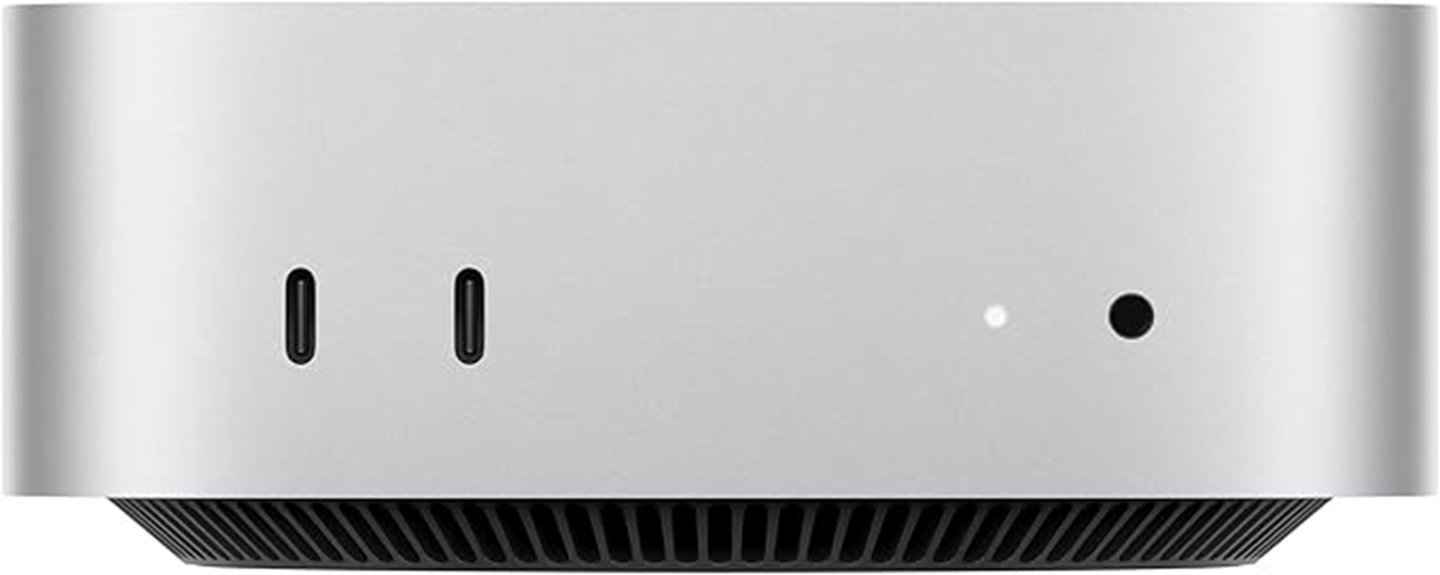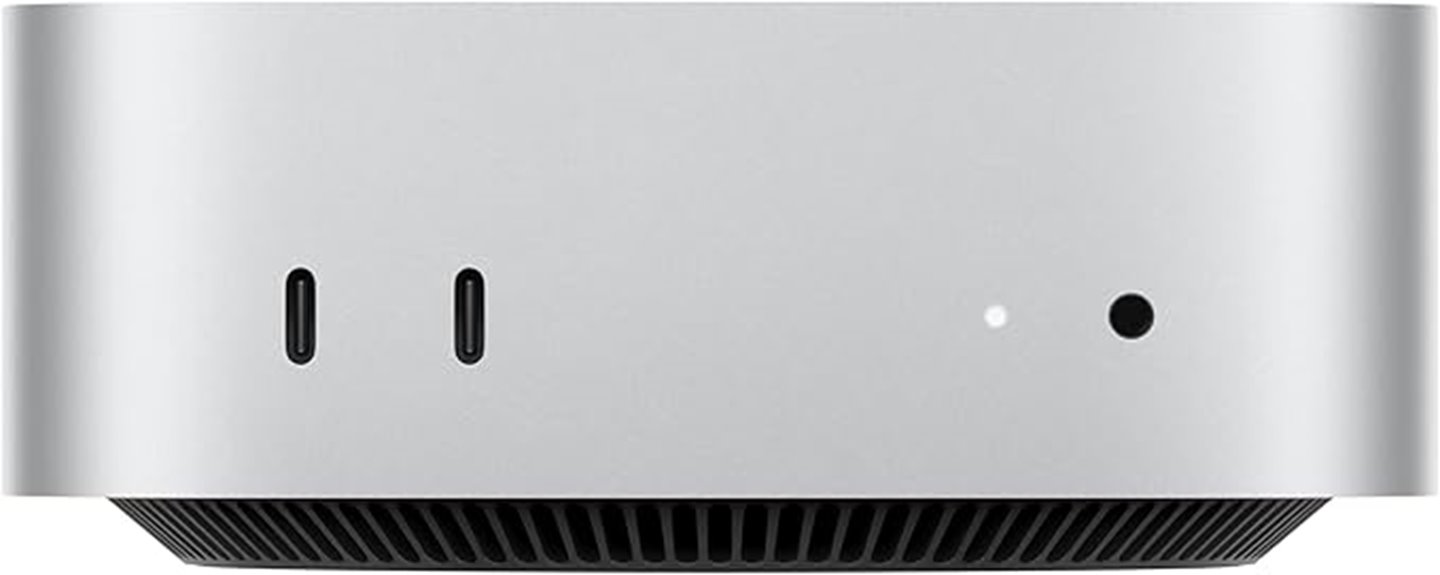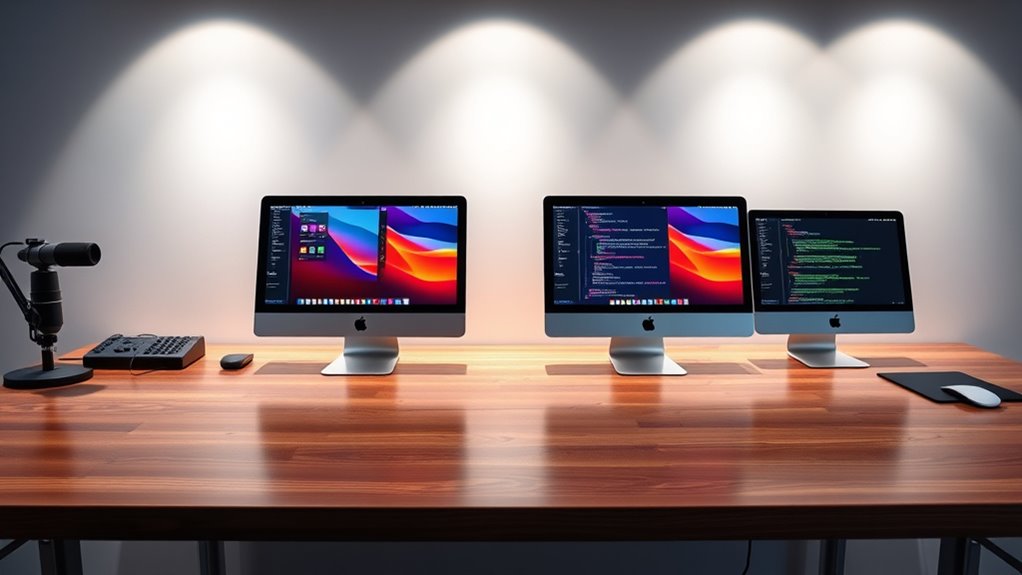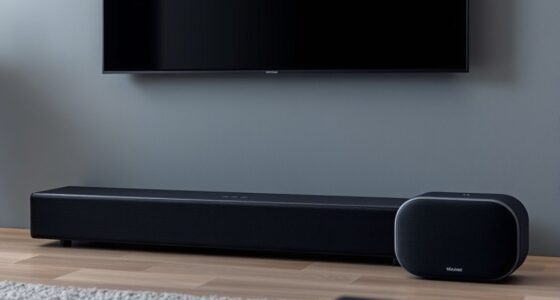Based on the latest information, the top four Mac Studio models for machine learning in 2025 include options with the M4 and M4 Pro chips, offering high core counts and Neural Engines for fast AI processing. These models combine powerful GPUs, ample memory, and efficient cooling to handle demanding datasets. If you’re curious about which model suits your needs best, keep exploring—there’s plenty of details to discover that can help you make the right choice.
Key Takeaways
- The latest Mac Studio models feature M4 Pro chips with up to 12-core CPU and 16-core GPU for optimal ML training and inference.
- They offer up to 32GB of unified memory and high bandwidth (120GB/s), supporting large datasets and multitasking.
- Equipped with multiple Thunderbolt 4 and HDMI ports, enabling extensive external hardware connections for ML workflows.
- The Neural Engine accelerates AI tasks, while hardware-accelerated media engines boost data processing efficiency.
- Compact design combined with high performance makes Mac Studio models ideal for demanding machine learning applications in 2025.
Apple 2024 Mac mini Desktop Computer with M4 Chip

If you’re looking for a compact yet powerful machine for machine learning tasks, the Apple 2024 Mac mini with M4 chip is an excellent choice. Its small five-by-five-inch design fits easily next to any monitor, making it perfect for space-constrained setups. Despite its tiny size, it delivers impressive performance with a 10-core CPU, 10-core GPU, and a 16-core Neural Engine. The Mac mini handles demanding applications like data processing, video editing, and multitasking effortlessly. Its efficient cooling system keeps noise levels low, while the hardware-accelerated media engines speed up workflows. Overall, it’s a highly versatile, space-saving powerhouse for professional and creative use.
Best For: professionals and creatives seeking a compact, high-performance desktop for machine learning, video editing, data processing, and multitasking in space-constrained environments.
Pros:
- Tiny yet powerful with M4 chip and advanced media engines for fast workflows
- Quiet operation and efficient cooling, ideal for noise-sensitive settings
- Seamless integration with macOS and Apple ecosystem, enhancing productivity
Cons:
- Non-upgradable RAM and storage, limiting future expansion
- Limited ports compared to larger desktops, necessitating external cables and adapters
- Higher cost relative to performance for entry-level users with minimal needs
Apple Mac mini 2024 Desktop with M4 Chip and 24GB Memory

The Apple Mac mini 2024 with the M4 chip and 24GB of memory stands out as an ideal choice for machine learning enthusiasts who need a compact yet powerful desktop. Its sleek five-by-five-inch design fits easily next to a monitor or in tight spaces, weighing only 1.5 pounds for portability. Powered by the M4 chip with a 10-core CPU and GPU, plus 24GB of unified memory, it handles multitasking, light video editing, and data processing with speed and efficiency. Connectivity options include Thunderbolt 4, HDMI, Ethernet, and Wi-Fi 6E, supporting multiple displays and fast data transfer. It’s a small package that delivers big performance.
Best For: creative professionals, machine learning enthusiasts, and users needing a compact yet powerful desktop for multitasking and data processing.
Pros:
- Compact, space-efficient design that fits easily alongside monitors or in tight spaces
- Powerful M4 chip with 10-core CPU and GPU, supporting demanding applications and multitasking
- Supports multiple high-resolution displays and fast data transfer with Thunderbolt 4 and Ethernet options
Cons:
- Non-upgradable RAM and storage, limiting future expansion possibilities
- Slightly higher price point for the base configuration compared to some competitors
- Limited ports on the front, requiring external hubs or adapters for additional connectivity
Apple 2024 Mac mini Desktop Computer with M4 Pro chip

Designed for demanding machine learning tasks, the Apple 2024 Mac mini with M4 Pro chip delivers exceptional performance in a compact package. Its 5×5-inch design fits easily next to monitors or anywhere in your workspace. Powered by the new M4 Pro chip, it features a 12-core CPU and 16-core GPU, handling complex scenes and large code compilations with ease. With 24GB of unified memory and 512GB SSD storage, it ensures fast, smooth workflows. Connectivity options include Thunderbolt, HDMI, Gigabit Ethernet, and front-facing USB-C ports. This tiny powerhouse seamlessly integrates with Apple’s ecosystem, supporting macOS apps and enhancing productivity without guaranteeing desktop-level power.
Best For: professionals and developers seeking a powerful, compact desktop for demanding machine learning, coding, and creative tasks within the Apple ecosystem.
Pros:
- Compact design easily fits in small or cluttered workspaces
- Powerful M4 Pro chip with 12-core CPU and 16-core GPU for demanding workloads
- Seamless integration with macOS and Apple ecosystem features
Cons:
- Limited 512GB SSD storage may require external solutions for large data needs
- No dedicated graphics card options, which could impact high-end gaming or certain professional workloads
- Price point may be higher relative to other compact desktops with similar specs
Apple 2024 Mac mini Desktop Computer with M4 Chip

With its compact size and powerful M4 chip, the 2024 Mac mini is an excellent choice for machine learning tasks, especially when space and quiet operation matter. Its five-by-five-inch form factor fits easily next to a monitor, making it ideal for small setups. The M4 chip delivers a 10-core CPU, 10-core GPU, and hardware-accelerated ray tracing, providing robust performance. With 16GB of unified memory (expandable to 24GB or 32GB) and fast SSD storage, it handles large datasets efficiently. The Mac mini supports multiple high-resolution displays, fast connectivity, and runs silently, making it perfect for intensive ML workflows in limited spaces.
Best For: users seeking a compact, powerful, and quiet desktop ideal for machine learning, multimedia editing, and small-space professional setups.
Pros:
- Small footprint with a sturdy and sleek design that fits easily next to any monitor
- Powerful M4 chip with 10-core CPU and GPU, supporting demanding tasks like ML and video editing
- Quiet operation with minimal heat generation, suitable for noise-sensitive environments
Cons:
- Non-upgradable RAM and storage, limiting future expansion options
- Limited external ports compared to larger desktops, which may require additional adapters or hubs
- Price may be higher relative to performance for some users seeking customizable hardware
Factors to Consider When Choosing a Mac Studio for Machine Learning

When choosing a Mac Studio for machine learning, I focus on several key factors. The processor’s performance and power, memory options, and GPU capabilities directly impact training speed and efficiency. I also consider expandability, ports, and storage flexibility to guarantee the setup meets my evolving needs.
Processor Performance Power
Choosing the right Mac Studio for machine learning largely depends on its processor performance power. A high number of CPU cores, such as 12 or more, directly boosts training and inference speeds for models. A powerful GPU, like a 16-core or better, accelerates parallel processing vital for deep learning tasks. Hardware-accelerated ray tracing and dedicated media engines improve data handling efficiency for complex workloads. Faster memory bandwidth—120GB/s or higher—ensures quick data transfer between components, minimizing bottlenecks. Additionally, integrated Neural Engines and advanced hardware features in the processor help improve performance and reduce latency. Together, these elements create a robust processing environment essential for efficient machine learning workflows. Prioritizing processor power is key to getting the most out of your Mac Studio for AI projects.
Memory Capacity Options
Selecting the right memory capacity is crucial for optimizing your Mac Studio’s performance in machine learning tasks. Larger memory options, like 24GB or 32GB, allow for smoother handling of large datasets and complex models. More RAM improves multitasking and minimizes disk swapping during intensive training, boosting overall speed and responsiveness. When choosing a Mac Studio, consider your dataset size and model complexity—opting for higher memory configurations can make a significant difference. While upgrading to larger unified memory may come with additional costs, the performance gains for demanding machine learning tasks are often well worth it. Confirming you have enough memory ensures your workflows run efficiently, reducing bottlenecks and improving processing times for your most intensive algorithms.
GPU and Neural Engine
Have you considered how the GPU and Neural Engine impact your Mac Studio’s performance in machine learning tasks? The GPU handles parallel processing, which is essential for training complex models efficiently. A more powerful GPU with additional cores means faster, more capable data processing. The Neural Engine accelerates AI computations, providing quicker inference and training times, especially with higher core counts. Hardware-accelerated features like ray tracing and media engines can support advanced data visualization and processing needs. When combined, the Neural Engine and GPU deliver optimized performance and energy efficiency, enabling smoother workflows and faster results. Choosing a Mac Studio with a robust GPU and Neural Engine ensures you’ll handle large-scale machine learning workloads effectively, making it a critical consideration for any serious AI developer.
Expandability and Ports
Since expandability is limited within the Mac Studio itself, the ports become vital for supporting your machine learning workflows. The Mac Studio offers multiple Thunderbolt 4 ports, which are perfect for connecting high-speed external drives and numerous peripherals needed for data processing and model training. Its USB-C ports support fast data transfer and compatibility with external sensors or hardware accelerators, expanding your setup’s capabilities. An HDMI port allows direct connection to external displays or additional GPU setups, useful for large-scale training tasks. Additionally, the Ethernet options, including 10Gb Ethernet support, enable rapid data transfer from network storage or cloud services. Because internal hardware upgrades are limited, selecting the right ports at purchase is essential for future-proofing and ensuring your workflow remains flexible and efficient.
Storage Solutions Flexibility
While the Mac Studio’s ports guarantee strong connectivity for peripherals and external hardware, storage flexibility plays a vital role in supporting your machine learning projects. Internal SSD capacity varies, so it’s important to choose a model with enough storage to handle large datasets, as upgrades aren’t possible after purchase. Higher SSD options, like 1TB or 2TB, can better meet demanding project needs. External drives with Thunderbolt 3 or 4 offer high data transfer speeds and expand storage without sacrificing performance. Connecting multiple external drives provides scalable options, guaranteeing you can grow your storage as your datasets expand. Ultimately, selecting the right initial capacity and considering external solutions guarantees your machine learning workflow remains smooth and efficient.
Compatibility With ML Tools
Choosing a Mac Studio for machine learning requires careful attention to its compatibility with essential ML tools and frameworks. First, verify the Mac Studio has a compatible GPU, like the M4 Pro’s 16-core GPU, to handle accelerated workloads efficiently. Confirm that the system supports key ML frameworks such as TensorFlow, PyTorch, and Apple’s Core ML platform. It’s also vital to confirm the unified memory, which can go up to 32GB or more, meets your large dataset and model training needs. Additionally, check if hardware acceleration features like neural engines are compatible with your tools. Finally, verify the macOS version is up-to-date to support the latest software optimizations. Compatibility guarantees smooth development and training processes, maximizing your machine learning productivity.
Power Efficiency and Cooling
Power efficiency and effective cooling are crucial considerations when selecting a Mac Studio for machine learning. Using power-efficient components like the M4 chip helps cut energy consumption while delivering high performance for demanding ML tasks. Good cooling systems prevent thermal throttling during intensive workloads, keeping processing speeds steady. Optimized hardware design reduces heat generation, allowing for quieter operation, which is especially important in noise-sensitive environments. Additionally, improved power efficiency extends the system’s lifespan by decreasing thermal stress on internal parts, ensuring more reliable long-term use. Adequate cooling solutions also allow the Mac Studio to handle prolonged training sessions and large datasets without overheating or performance drops. Balancing power efficiency with effective cooling is essential for maintaining consistent, high-quality machine learning performance.
Frequently Asked Questions
How Do Mac Studio Models Compare in Machine Learning Performance?
Mac Studio models vary in machine learning performance, with newer versions offering significant improvements. I’ve found that models equipped with the latest M2 Ultra chip handle complex ML tasks more efficiently, thanks to enhanced GPU and neural engine capabilities. They outperform earlier models, providing faster processing, better multitasking, and smoother AI workflows. If you’re serious about machine learning, investing in the latest Mac Studio guarantees you get top-tier performance.
Which Mac Studio Configurations Offer the Best Value for AI Projects?
Looking for the best value for AI projects? I’d recommend the Mac Studio with the M2 Ultra chip, 64GB RAM, and a 1TB SSD. It balances power and cost, making complex machine learning tasks smoother without breaking the bank. Isn’t it better to invest in a setup that handles your projects efficiently? This configuration gives you solid performance and future-proofing, perfect for AI work on a budget.
Are External GPUS Compatible With Mac Studio for Enhanced ML Tasks?
Yes, external GPUs can be compatible with Mac Studio, but compatibility depends on the specific GPU and connection type. I’ve found that Thunderbolt 3 or 4 enclosures work best, allowing me to boost graphics and ML processing power. However, macOS has limited support for some GPU models, so I recommend checking Apple’s latest compatibility lists before investing. This setup can markedly enhance my machine learning tasks when configured properly.
How Does Software Optimization Impact Mac Studio’s ML Capabilities?
Software optimization is the secret sauce that can turn a good Mac Studio into a machine learning powerhouse. When developers fine-tune code and leverage optimized frameworks, I notice faster training times and better resource management. It’s like giving your hardware a turbo boost, making complex ML tasks smoother and more efficient. Without proper optimization, even the best hardware can sit idle, underperforming its true potential.
What Future Mac Studio Updates Could Improve Machine Learning Efficiency?
Future Mac Studio updates could substantially boost machine learning efficiency by integrating more powerful neural engine hardware and enhancing GPU capabilities. I believe Apple will optimize software further, making ML tasks smoother and faster, especially with better support for machine learning frameworks. Improvements in thermal management and energy efficiency could also allow longer, more intensive training sessions. Overall, these updates will make Mac Studio even more appealing for ML developers like me.
Conclusion
If you’re serious about machine learning, the Mac Studio options I’ve reviewed are first-rate, but I know some might worry about cost. Trust me, investing in a powerful Mac Studio pays off with faster processing and smoother workflows, ultimately saving you time and effort. Don’t skimp on your tools—choose the model that best fits your needs now, so you can focus on innovating instead of waiting for your hardware to catch up.









